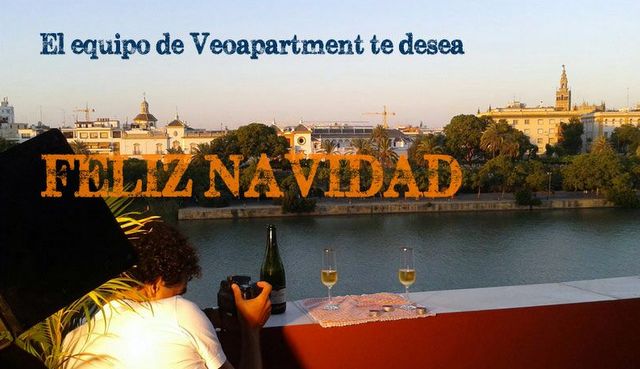
The Veoapartment Team wishes you a very Merry Christmas!

There can be few cities and architects in the world whose names are more closely linked than those of Barcelona and Antoni Gaudi. Born in 1852 (died 1926) he became a leading figure in the Catalan Modernist movement of the late 19th and early 20th centuries, but inspired by the forms he found in nature he developed a style of architecture and decoration that transcended labels and is nowadays seen as truly unique.
For the visitor to Barcelona there are four Gaudi creations that are absolute must-sees.
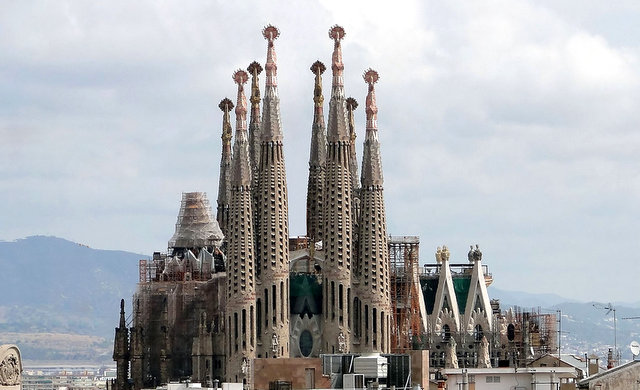 photo courtesy of wikimedia
photo courtesy of wikimedia
Sagrada Familia
The Sagrada Familia, or Basilica and Church of the Holy Family (it’s not a cathedral – Barcelona already has one of those), is considered to be Gaudi’s masterwork. He took control of the project in 1883, shortly after it began, and as of today, more than 130 years later, it is still under construction, though there is a target for completion of 2026 to mark the centenary of his death.
Both the scale and the intricacy of the work are amazing. The eight (so far) tapering towers rise out of a fairly mundane suburban backdrop, and the church’s three facades, representing the Nativity, the Passion and the Glory, are adorned with scenes from the life of Christ. As with all Gaudi’s work, it’s the attention to detail that fascinates, especially the more whimsical elements, like the tortoises that form the bases of some of the pillars.
Be prepared for long queues, which in the summer heat call for considerable fortitude and plenty of water!
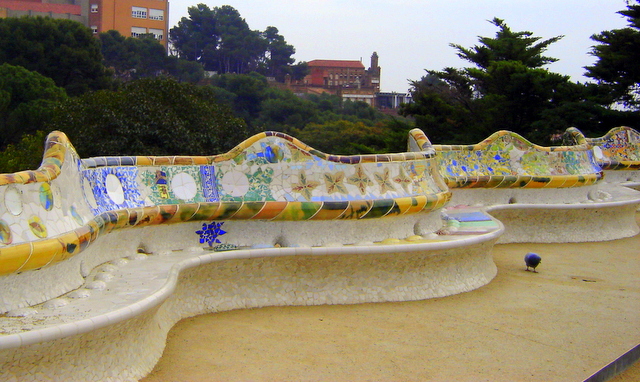 tiled benches in Parc Güell
tiled benches in Parc Güell
Park Güell
Quite different is Park Güell, originally conceived as a housing project, but now a municipal garden on a hill overlooking the north of the city. Here you can find some of Gaudi’s best known work, including the mosaic salamander, and the entrance pavilions that always remind me irresistibly of gingerbread houses, The hypostyle hall, with the terrace of curved benches that forms its roof, has an Egyptian inspiration, and like many of the architectural elements seems almost to have grown out of the ground.
Entrance to the park was free until last year – now there is an 8€ charge.
Casa Mila (La Pedrera)
Down on the Passeig de Gracia (Barcelona’s main shopping street) you can find the first of the two most famous Gaudi houses, designed and built by Gaudi for a wealthy Catalan businessman, the Mila House. It’s most obviously notable for being built almost entirely of curves with very few straight lines or surfaces. My favourite things here are actually the “witch-scarers” on the roof, which bear a striking resemblance to Star Wars stormtroopers, but the whole building is worth exploring at length.
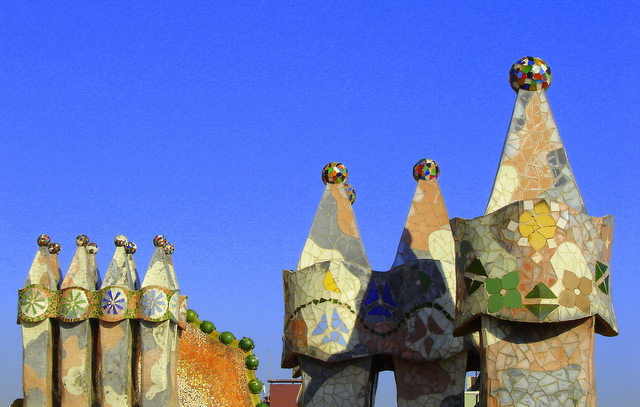 “dragon’s back” rooftop of Casa Batlló
“dragon’s back” rooftop of Casa Batlló
Casa Batlló
My favourite Gaudi of all, however, can be found a little further down the street. Casa Batlló, like the Mila totally renovated for a wealthy businessman, is also known locally as the “House of Bones”, and it’s easy to see why. The balconies of the façade closely resemble skulls, and the window supports of the main floor do look remarkably like bones. From inside, the effect of the curved windows is really stunning, but as at Mila, everything seems to be curved, and gives a slightly eerie feeling of being inside something living. Make sure to see the interior light-well, the atrium, with its bright tiles extending dizzyingly right up through the full height of the building.
Veoapartment has recently acquired several new additions to our holiday rental properties, many of them in the stylish Eixample and boho Gracia neighbourhoods, close to these fabulous Gaudi buildings and other important sights.
Whether you’re something of a “foodie”, or just a regular visitor seeing the sights, no visit to a Spanish city is complete without visiting at least one of its markets. Apart from its obvious practicality if you’re self-catering in an apartment (better than a hotel if you’re a group or family and staying more than a couple of nights), it’s one of the best ways of experiencing the day to day life and culture of the locals – what they buy and how they shop, and usually with an opportunity to sample some of it at a market cafe or bar. If it’s a bit overwhelming you could try one of the many market food tours such as The Barcelona Taste or Aborigens to get your bearings, or enjoy shopping and then cooking your purchases with an Eat With verified local host.
As you might expect, a city the size of Barcelona has quite a number of such markets, though the ones that the typical visitor is most likely to see are the three markets in and around the Ciutat Vella, the old city.
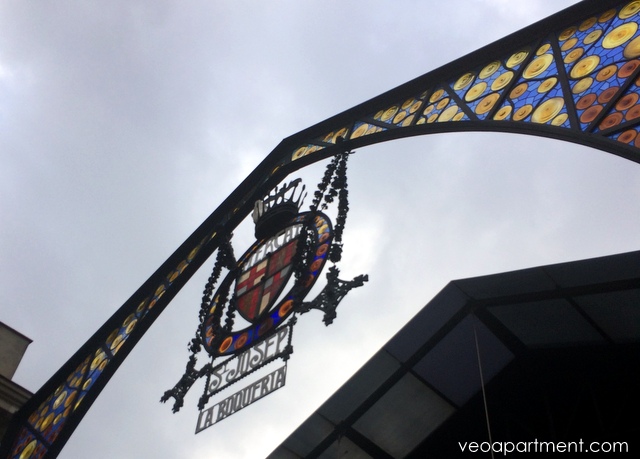 the entrance to La Boquería market
the entrance to La Boquería market
La Boqueria
The most well-known of these is certainly Sant Josep de la Boqueria, located on the infamous Las Ramblas in the heart of the tourist neighbourhood between the Barri Gotic and El Raval. There’s been a market hereabouts since at least 1217, though the current building was constructed between 1840 and 1853, and although it’s still very much a working market it has now become a major attraction in its own right. There’s an impressive entrance, complete with a coat of arms surmounted by a bat*, but it’s set just a little way back from the street, so it’s surprisingly easy to miss if you’re not looking for it. The space inside seems huge, a cathedral of food, and with almost 300 stalls there’s plenty to choose from.
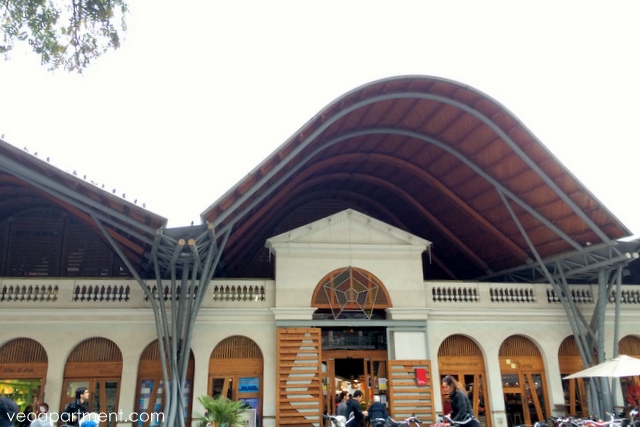 Santa Caterina is even more impressive when seen from above
Santa Caterina is even more impressive when seen from above
Santa Caterina
Santa Caterina market, just off the Via Laietana in the La Ribera neighbourhood was the first of Barcelona’s covered markets to be renovated (in 2005), and is now most notable for its modernist undulating coloured roof, which you can get a good view of from the top of the nearby cathedral, and all that fabulous local fresh food of course. Less crowded than the Boqueria, with more space and light around the stalls and fewer bars, it nevertheless has a definite charm of its own, and it’s well worth taking the time to come here.
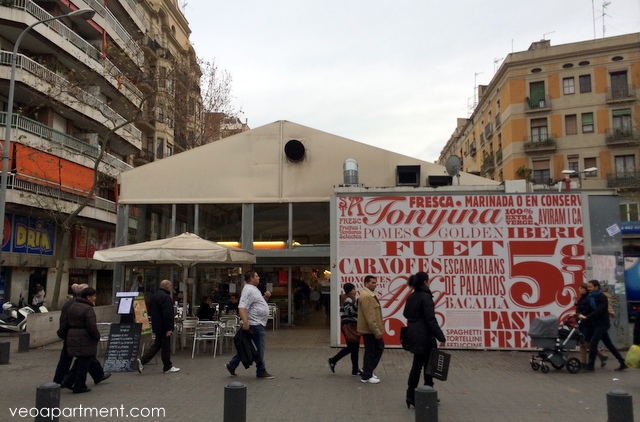 temporary installation for Sant Antoni Market
temporary installation for Sant Antoni Market
Sant Antoni
Sant Antoni is technically in the Eixample district, but really it’s right on the boundary with the old El Raval neighbourhood, where it was built in the 1880s to serve the new neighbourhoods of the growing city. Since 2009 it has been housed in rather shabby temporary accommodation on the Ronda Sant-Antoni while the original building is being renovated. Work should be completed, and the market restored to its proper home, in 2016, together with the famous Sunday collectors’ and books market. The original ground plan in the shape of a Greek cross, surrounded by a circular covered gallery where the non-food stalls are housed, will be preserved, and the new building will also incorporate the medieval remains discovered during the works.
Other markets worth a visit include La Barceloneta, with it’s unusual roof, La Concepció in the Eixample which has a classic cast-iron and glass frontage, and Sant Marti in the eastern part of the city.
* The Bat is a heraldic symbol of the former crown of Aragon, and is thought to have originally represented a dragon. Officially it is no longer part of the coat of arms of Barcelona, but still appears on older versions and on some street furniture such as street lamps.
Barcelona is Spain’s biggest city, with a long history stretching back to pre-Roman times. It’s also one of Spain’s economic powerhouses, and in the early 20th century the confidence of its wealthy citizens spawned the Modernista movement in architecture and city planning that created the modern city. As you might expect from this, there’s plenty to see and do in Barcelona, whatever your interests.
Sagrada Familia
Still under construction (it was started in 1882), the Church of the Holy Family is the astonishing masterwork of modernist architect Antoni Gaudi. A unique combination of gothic and modernist elements, especially its unusual spires, make it a stunning visual feast, and probably Barcelona’s number 1 attraction.
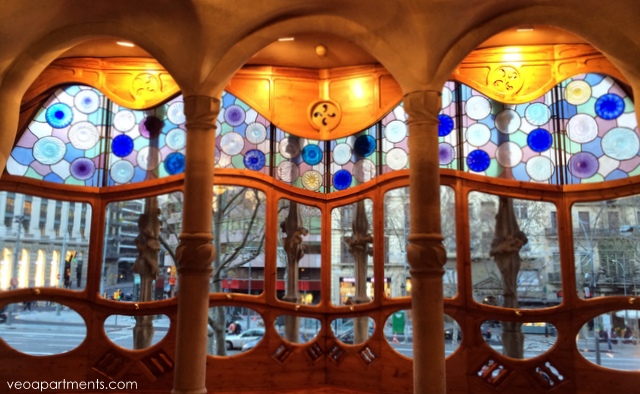 inside the salon at Gaudí’s Casa Battló
inside the salon at Gaudí’s Casa Battló
The Gaudi Houses
After the Sagrada Familia, Casa Batllo (one of my all time favourite buildings) and Casa Mila (La Pedrera) in the Passeig de Gracia are the two most famous of Gaudi’s creations. Built in the Catalan modernista style of the early 20th century they are notable for being designed with almost no straight lines, and for the incredible detail of their decoration. They also give an insight into how the upper classes lived in the 1920s and 30s. Be prepared for queues, but trust me, it’s worth the wait.
Las Ramblas
Take a stroll down Las Ramblas, the busy, bustling main tourist street that runs from Plaça Catalunya down to the Columbus Monument by the port. It’s a wide, tree-lined avenue full of kiosks, cafes and street-performers of all kinds. Famous sights include the Canaletes Fountain, and the mosaic by Joan Miró. At the top end, between the old city and the 19th century Eixample district, is the grand open space of Plaça Catalunya, with its fountains and statues, the official city centre. Halfway down is the famous La Boqueria Market, one of the largest in Spain, and always full of people buying and selling a huge range of fresh produce. At the southern end is the Columbus Monument, built for the 1888 exhibition, with the statue of the great explorer pointing out to sea. The Avenue also serves to separate the neighbourhood of El Raval to the west from the oldest part of Barcelona, the Barri Gotic (Gothic quarter).
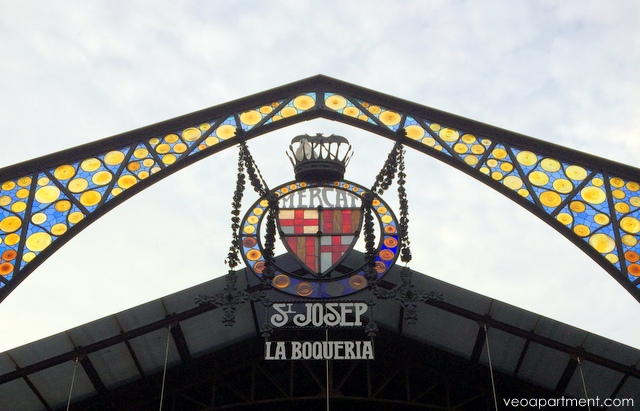 entrance to La Boqueria Market in Las Ramblas
entrance to La Boqueria Market in Las Ramblas
Barri Gotic and El Born
The Barri Gotic is the oldest part of Barcelona, and still retains most of its medieval street layout and a number of medieval buildings, although two of its principle sights, the Plaça Real and the facade of the Cathedral (although the body of the building is 15th century), are more modern. The neighbourhood to the east, El Born, is another historic area that is worth visiting. It’s home to some of the city’s most interesting bars as well as the Caterina Market and new El Born Cultural Centre, housed in the renovated old market space.
Montjuic
Wherever you are in Barcelona, you can always see Montjuic hill looming over the city. If you’ve a head for heights take the cable car up to top from the port. The views over the city are fantastic, but there’s lots of other stuff up here, too, including the old castle, several important museums, and the Poble Espanyol, an architectural museum like you’ve never seen before with 117 buildings in various Spanish styles. On winter evenings go down by way of the Magic Fountains (presently closed for restoration) and watch one of the light and music shows.
Aquarium
If you have children take them to the Aquarium, which has underwater viewing tunnels through tanks with an abundant variety of marine life. The sight of shsrks and other large fish swimming so close by is quite awe-inspiring.
Ciutadella Park
Barcelona’s principal city centre park is both a zoological and botanical garden and includes a lake, a cascade and fountains, and several museums. Just the place for a stroll in the sunshine.
Nou Camp Stadium
Perhaps not everyone’s idea of a tourist attraction, but the home of Barcelona’s famous football team is up there with the Wembleys and San Siros, and the club’s museum is the second most visited in Catalonia.
Picasso Museum
The 3500 works by Spain’s most famous painter, spread through several former palaces, make this the largest Picasso collection anywhere in the world, and allow you to follow his artistic development from childhood to old age. An absolute must for all art lovers.
 the Gaudí dragon in Parc Güell
the Gaudí dragon in Parc Güell
Parc Güell
Parc Güell is a bit of a trek out into the northern suburb of La Gracia, but Gaudi’s gardens with their many fascinating architectural elements are well worth the time and effort (and nowadays, entrance fee). Here you can see, among other things, the famous mosaic “dragon” and the hypostyle hall with the mosaic seating area on its roof.
On top of all that, there is always the food, the beaches, and the weather, and our quality apartments will put you in the thick of the action.
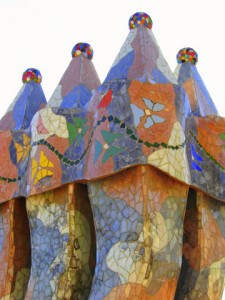 Our new veoapartment Barcelona page is now live!
Our new veoapartment Barcelona page is now live!
We are offering a small but high quality selection of holiday apartments, carefully chosen both for their modern comforts and “it feels like you’re at home” qualities, and for their locations close to the most important sights in the city. With veoapartment’s usual attention to detail and the high priority we place on customer service, this means that you can book with confidence for a no-worries holiday.
Why come to Barcelona?
Lots of reasons. It’s the capital of Catalonia and Spain’s second largest city after Madrid, and also its most international and cosmopolitan. Legend has it that it was founded by Hamilcar Barca, the grandfather of Hannibal (of crossing the Alps with elephants fame), but whether this is true or not it certainly has both a long history and a modern European feel.
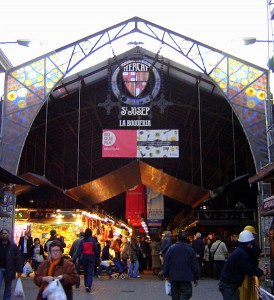 And there’s plenty to see and do. From the unofficial heart of the city, the grand Plaza Catalunya, you can stroll down the bustling length of the famous Las Ramblas and pay a visit to La Boqueria, the main provisions market founded in the 13th century. Go into the Barrio Gothic, the old quarter of the city, which still has many medieval buildings, including the Cathedral, while the Plaça Reial (Royal Plaza), a grand 19th century square, has lots of restaurants and a busy nightlife. Seafront attractions include the famous aquarium with its underwater walkways, and for those with a head for heights there’s the cable car to the top of the brooding bulk of Montjuic mountain.
And there’s plenty to see and do. From the unofficial heart of the city, the grand Plaza Catalunya, you can stroll down the bustling length of the famous Las Ramblas and pay a visit to La Boqueria, the main provisions market founded in the 13th century. Go into the Barrio Gothic, the old quarter of the city, which still has many medieval buildings, including the Cathedral, while the Plaça Reial (Royal Plaza), a grand 19th century square, has lots of restaurants and a busy nightlife. Seafront attractions include the famous aquarium with its underwater walkways, and for those with a head for heights there’s the cable car to the top of the brooding bulk of Montjuic mountain.
Going north from Plaza Catalunya you go into the Eixample district, with its broad avenues and open spaces, the home of modernist Barcelona, which is exemplified by the work of Antoni Gaudi. Must-sees here include the unique church of Sagrada Familia, one of the city’s most iconic sights, and the Casa Batlló in the Passeig de Gracia. Don’t be put off by the price or the queues – it’s worth it. Take the opportunity to do a little shopping, too; this is one of Europe’s most famous and stylish shopping streets.
Barcelona has a wide selection of bars and restaurants, and the climate’s great, too. Hot and sunny in summer, but not too hot to be out walking, and still quite mild in winter. Time to treat yourself to a memorable holiday!